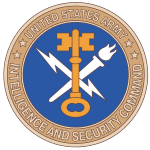United States Army Intelligence and Security Command
|
United States Army Intelligence and Security Command |
|
|---|---|
|
INSCOM emblem |
|
| Lineup | 1977 |
| Country | United States of America |
| Armed forces | United States Armed Forces |
| United States Army | army |
| Branch of service | Military intelligence |
| Type | Direct reporting unit |
| Fort Belvoir | Fairfax County , Virginia |
| Commander US Army Intelligence & Security Command | |
| Commanding General | Major General Stephen G. Fogarty |
The United States Army Intelligence and Security Command ( INSCOM ) is the intelligence and security main command of the US Army .
INSCOM is also part of the Central Security Service (CSS). The Air Force and Navy , as part of CSS, have similar organizations with the Air Force Intelligence, Surveillance and Reconnaissance Agency and the Network Warfare Command .
Naming and organization
In Anglo-Saxon countries, there is generally no strict distinction between securing one's own information and obtaining information from the enemy. Instead, these functions are viewed as “two sides of the same coin” and are always brought together in a common organization. This is known as the "Intelligence and Security Organization". Examples are the British GCHQ , the Canadian CSE or the American NSA . INSCOM can be seen as part of the NSA's army.
All Anglo-Saxon countries (USA, Great Britain, Canada, Australia and New Zealand) work very closely together in the area of "Intelligence and Security". This is sometimes referred to in public as the " Echelon ".
In Germany, these functions are divided between the BSI , BND and the Strategic Reconnaissance Command .
safety
INSCOM has the defensive task of ensuring the security of the US Army's electronic systems (computers, communications and ciphers) and the security of stationed troops. The latter includes the defense against subversion (decomposition) and espionage against stationed troops.
Intelligence gathering and education
The offensive task of INSCOM is the investigation of opposing positions, plans and intentions. Technical methods include radio direction finding , radio traffic analysis , breaking of ciphers ( cryptanalysis ), offensive network operations ("hacking"). Telecommunication reconnaissance in particular is highly developed, with systems such as GUARDRAIL or stationary (satellite) receiving antennas (sometimes called echelons ). Of course, messages from other systems such as Rivet Joint (air forces) are also exchanged via NSA / CSS . Other important technical systems are radar sensors such as JSTARS and Global Hawk as well as optical satellites. These are operated in conjunction with the Air Force and the National Reconnaissance Office . NSA / CSS also operates electronic reconnaissance satellites such as the MERCURY satellites (with the help of the air force) and makes the messages obtained from them available to INSCOM. Interviewing prisoners and other "human intelligence" activities are also part of INSCOM's job.
assignment
- The secret service support of all military plans of the Army for all possible areas of operation in South America, Asia, Africa and Europe.
- The use of all means of electronic intelligence (SIGINT = Signals Intelligence ).
- The use of human sources (HUMINT = Human Intelligence ) includes the use of all human sources, from intelligence officers (e.g. as military attaché ) to agents.
organization
Subordinate units ( Major Subordinate Commands ) are:
Information mission command
- 1st Information Operations Command (Land)
Brigades
- 300th Military Intelligence Brigade
- 501st Military Intelligence Brigade
- 513th Military Intelligence Brigade
- 704th Military Intelligence Brigade
- 66th Military Intelligence Brigade (responsible for Europe)
(Among other things, Army share in the Echelon satellite communication listening system Menwith Hill , Great Britain)
groups
- 115th Military Intelligence Group
- 500th Military Intelligence Group
- 470th Military Intelligence Group
- 116th Military Intelligence Group
- 108th Military Intelligence Group
- 902nd Military Intelligence Group
Locations
INSCOM's headquarters are in Fort Belvoir, Virginia. The 66th Military Intelligence Brigade acts as a European detachment at Wiesbaden Army Airfield.
Comparable German organizations
- Strategic reconnaissance command of the Bundeswehr
- Military Counterintelligence Service (MAD) of the Bundeswehr
- Federal Intelligence Service
- Federal Office for Security in Information Technology
See also
literature
- James Bamford: The Puzzle Palace . (via NSA / CSS), ISBN 978-0-14-006748-4 .
Web links
- United States Army Intelligence and Security Command
- Military Intelligence Professional Bulletin ( Memento from June 18, 2006 in the Internet Archive ) - INSCOM's “house newspaper”
Individual evidence
- ↑ Major General (MG) George J Franz III. Commanding General's Biography. Archived from the original on January 15, 2015 ; accessed on July 15, 2013 .
- ^ Major Subordinate Commands. Archived from the original on November 30, 2010 ; accessed on November 28, 2010 (English). .

